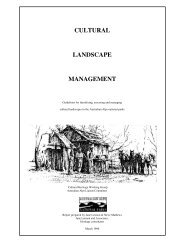Proceedings of an International Year of Mountains - Australian Alps ...
Proceedings of an International Year of Mountains - Australian Alps ...
Proceedings of an International Year of Mountains - Australian Alps ...
You also want an ePaper? Increase the reach of your titles
YUMPU automatically turns print PDFs into web optimized ePapers that Google loves.
Methodological overview <br />
Despite the very large number <strong>of</strong> empirical applications <strong>of</strong> the TCM, several theoretical <strong>an</strong>d practical<br />
problems have been identified. Interested readers are directed to Stoeckl (1999); Smith (1989) <strong>an</strong>d<br />
Fletcher et al (1990), all <strong>of</strong> whom provide a detailed overview <strong>of</strong> m<strong>an</strong>y <strong>of</strong> those problems. Suffice to say<br />
here – final estimates are not as accurate as <strong>of</strong>ten portrayed. This study therefore provides a r<strong>an</strong>ge <strong>of</strong><br />
different estimates; that r<strong>an</strong>ge reflecting some <strong>of</strong> the uncertainties associated with the methodology.<br />
More specifically, this study uses the zonal TCM to generate a r<strong>an</strong>ge <strong>of</strong> estimates <strong>of</strong> the recreation use<br />
value <strong>of</strong> each <strong>of</strong> seven different regions within the Australi<strong>an</strong> <strong>Alps</strong>. Rather th<strong>an</strong> attempting to determine<br />
travel costs from each zone, we use the ‘great circle’ dist<strong>an</strong>ce between each zone <strong>of</strong> origin <strong>an</strong>d the<br />
location from which the survey was collected as a measure <strong>of</strong> travel costs (assuming a price <strong>of</strong> dist<strong>an</strong>ce =<br />
$ 0.50 per km since dist<strong>an</strong>ce is one-way). Dist<strong>an</strong>ce, the population <strong>of</strong> each zone, <strong>an</strong>d other<br />
socioeocnomic measures (taken from the ABS’s 1996 census) are used as regressors within the visitation<br />
equation <strong>an</strong>d the dependent variable is defined as the number <strong>of</strong> sampled visitors from each zone. We<br />
allow for multiple-site visitors problem by using dummy variables to identify multiple-site visitors, <strong>an</strong>d<br />
estimate five different visitation equations (using five different functional forms) for each region.<br />
The results<br />
A total <strong>of</strong> 4,614 questionnaires were completed by Australi<strong>an</strong> residents. This allowed us to allocate 16528<br />
Australi<strong>an</strong> residents into 2293 different postal ‘zones’. We then divided that data into seven different<br />
sub-sets; according to which region (within the Australi<strong>an</strong> <strong>Alps</strong>) the individuals were visiting when they<br />
completed the questionnaire.<br />
For each region, visitation equations were estimated using 5 different functional forms. The double-log<br />
version was chosen as the “correct” functional form on both practical <strong>an</strong>d theoretical grounds (see<br />
Stoeckl, 1999). From this point onwards, we therefore focus on estimates associated with the double-log<br />
model.<br />
Coefficients from the double-log visitation equation were used to generate the following estimates <strong>of</strong> CS<br />
attributable to our sample <strong>of</strong> visitors (assuming a travel costs = 50 cents per km). These estimates were<br />
scaled downwards for a r<strong>an</strong>ge <strong>of</strong> ‘plausible’ travel costs (10 <strong>an</strong>d 30 cents per km), producing a r<strong>an</strong>ge <strong>of</strong><br />
‘plausible’ consumer surplus estimates attributable to our sample <strong>of</strong> visitors (Table 2).<br />
Region<br />
CS a ten cents<br />
per km<br />
CS at thirty cents<br />
per km<br />
Per Person CS<br />
at ten cents<br />
per km<br />
$258<br />
$113<br />
Per Person CS<br />
at thirty cents<br />
per km<br />
$773<br />
$338<br />
Yarr<strong>an</strong>gobilly<br />
Jindabyne<br />
$259,124<br />
$1,049,092<br />
$777,372<br />
$3,147,276<br />
Tharwa $356,694 $1,070,082 $537 $1,612<br />
Mt Buffalo<br />
$582,034 $1,746,102 $217<br />
$652<br />
Falls Creek<br />
$551,102 $1,653,306 $446<br />
$1,338<br />
Bright<br />
$518,780 $1,556,340 $402<br />
$1,206<br />
$3,428,310.00 $10,284,929.00 $286.38 $859.00<br />
Table 2: “Plausible” Consumer Surplus Estimates from the sample <strong>of</strong> visitors<br />
(Using the double-log visitation equation)<br />
152<br />
Celebrating <strong>Mountains</strong> – An <strong>International</strong> <strong>Year</strong> <strong>of</strong> <strong>Mountains</strong> Conference<br />
Jindabyne, New South Wales, Australia

















